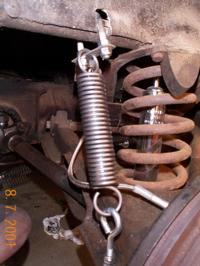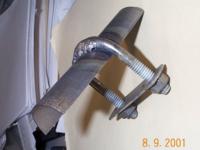
Larry Forman posted the following on FastVairs, it sounds like a potentially good way to limit rear end jacking on an early model, it certainly did well on a Devin.
These ideas have been incorporated in Devin Cs and work well in that application. Since the Devin C uses primarily standard EM rear suspension, but with slightly shorter axles, it may work for the EM car rear suspension, but is currently unproven. This would not be recommended for the 64s with the transverse leaf spring. You should either use this technique to solve the wheel jacking problem, or alternatively use a sway bar, camber compensator or transverse leaf spring - not together since they may counteract or interact with each other. One of the unique features of this approach is that it can easily and quickly change the suspension and the amount of negative camber for various autocross courses or for the street. In fact, you can adjust this so the car can be individually tuned to favor right or left cornering, depending upon the track.
Tom Schrumm and Bill Devin worked out these improvements for Tom's Devin C. This was based upon the work that Bill Devin did on his Crosley in 1949 when he had these secondary springs on all four corners. Tom has spent many hundreds of hours behind the wheel of his Devin C and tried countless improvements. What is described here worked the best of anything by a wide margin. For the Devin C, with these changes the car will corner absolutely flat with no rear wheel jacking.
The problem with the EM rear swing-axle suspension is that under extreme cornering the body tends to roll to the outside with the inside lifting so the inside rear wheel will tuck in or "wheel jack." This is accentuated by several factors including the inside rear spring pushing the lower a-arm down and the downward force of any gas charged shock absorber doing the same thing.
The solution is to do two things. First, eliminate any force from the shock absorber that would tend to press the lower a-arm down as is typical of gas charged shocks. Second, add a secondary spring that counteracts the downward force of the rear suspension springs under extreme cornering. These two changes do wonders for reduction of rear wheel jacking, at least for the Devin C. For the EM Corvairs, the wheel jacking problem is less severe, surprisingly over the Devin C, because the axles are longer for the EM Corvair car, and even longer for the FC.
There is one shock absorber that I know of that will not exert outward force and it can be adjusted to control rebound. It is manufactured (until recently) by Carrera, as their p/n 3956si. These shocks are also for 59-87 El Camino front shocks or 67-81 Camaro front shocks. Carrera has discontinued p/n 3956si and replaced it with p/n 2856J, which is painted white rather than the 3956si's chrome but does NOT have the same features, since it lacks the adjustment ability. The adjustment ability is important in reducing rear wheel jacking.
The primary customer for the Carrera 3956si shock was Clark's Corvair. They received their last shipment of p/n 3956si in early 2001 and Carerra has decided not to make any more in the future unless they can make a run of 100 sets. Clark's Corvair is currently the only source for these shocks in 2001.
If you call Carerra and describe the application, they will recommend a substitute non-adjustable shock and say that it is equivalent - NOT! The 3956si has three adjustments: 20/80%, 50/50% and 80/20%. This means that the shock can be adjusted so it will compress 50% and rebound 50% for the center setting or it can be adjusted for the softest or firmest rebound. The firmest rebound will tend to resist and reduce the amount of upward movement of the upper a-arm relative to the lower a-arm, which is what you want.
You want the standard rear springs rather than the heavy duty ones that might be cut down. The reason for this is that stronger primary springs will tend to overpower the secondary opposing springs.
You can obtain the secondary springs from Century Spring Corp's (213) 749-1466 spring #81134, which is an extension spring EXT=0.1.250 and L=6.00. These cost about $25.10 (in 2014) each. This is a 6-inch extension spring with 176 lb. pulling force.
For the Devin there is an upper rear strut rod that can be used as a mounting point for standard U-bolt welded to slit tubing. The U-bolt is welded to a four-inch piece of tubing that was slit and mounted to the top of the Devin's rear strut rod with the U-bolt pointed downward. A cross bar mounted to the U-bolt was drilled in the middle to accept the upper end of the secondary extension spring. The lower part of the spring goes into the eyebolt, which goes into the hole at the rear of the lower A-arm.
When autocrossing the negative camber can be increased to 1 or possibly 2 degrees using the rear secondary extension spring adjustment. When adjusting the extension spring, either have someone of similar weight sit in the driver's seat, or provide more tension on the right side spring without anyone in the car. If the car is normally at one degree negative, adjust the secondary spring until you obtain the desired negative camber.
One caution that is important to remember: since the primary spring can easily overpower the weaker secondary spring, you must be careful to NEVER jack up the rear and let the wheel hang down which might stretch the secondary spring. So always plan on jacking up each rear wheel underneath the lower A-arm.
These photos show the installation in a Devin C. The upper rear strut bar is hidden behind a body sub panel, but a cutout allowed access for the U-bolt. The second photo (out of focus) shows a welded U-bolt to the half tube. There will need to be a different mounting for the upper attachment point in an EM car.
| Click for larger image. | |
 |
 |
This technique MIGHT be adaptable to a FC, but I would recommend using two of these springs per side due to the heavier primary rear springs.
I would be interested in hearing any comments, both pro and con, to these ideas and especially for those who take the ideas and actually try them on your Corvairs. I intend to try this on my Greenbrier, just because. I can be e-mailed at larry@forman.net.